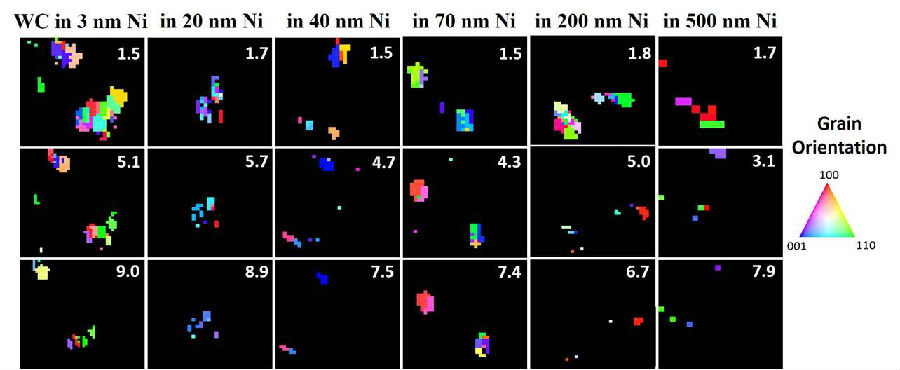Smaller nanocrystals may not rotate more after all - Dr. Bin Chen
MARCH 2, 2017
For more than 60 years, the conventional belief has been that smaller grains of materials rotate more under stress due to the motion of grain boundary (GB) dislocations. Under the guidance of Dr. Bin Chen of the Center for High Pressure Science & Technology Advanced Research (HPSTAR), Xiaoling Zhou, a Ph.D. student of HPSTAR, and her co-workers observed that nanocrystals of a critical grain size rotate more than any other grain size. The results were published today in the journal Physical Review Letters: “Reversal in the Size Dependence of Grain Rotation”.
Plastic deformation is a common physical process of solid materials that usually determines materials’ strength. General knowledge is well established for the plastic deformation of materials at a micrometer scale. However, the plastic deformation of nanomaterials has long been an outstanding challenge for the research and industrial communities. Grain boundary sliding and grain rotation are thought to be the dominant mechanisms of plastic deformations at the nanoscale. Grain rotation is significantly relevant in nano-mechanics. Classic theories developed in the 1950’s and later (e.g. the Read-Shockley model) stipulate that grain rotation can be accomplished primarily by grain boundary dislocations.
 Although the observation of grain rotation in the deformation of micrometer-sized crystals is feasible [L. Margulies et al. Science 291, 2392 (2001)], in situ probing the grain rotation of ultrafine nanocrystals is difficult, precluding further investigation of nanoscale mechanics. To overcome technical difficulties, Xiaoling Zhou and her co-workers used Laue x-ray micro-diffraction to monitor grain rotation markers in nickel media of various grain sizes. “Under the same stress conditions, the same sized tungsten carbide marker of grain rotation should rotate the same amount on average”, said Dr. Bin Chen, the project team leader, “but surprisingly, we observed that the marker crystals in the 70 nm nickel media rotated more than in any other size of nickel media”. They inferred that the reversal in the size dependence of the grain rotation arose from the crossover between the grain boundary dislocation-mediated and grain interior dislocation-mediated deformation mechanisms. This new finding could reshape our views and knowledge of nanometal plastic deformation, which provides guidance for understanding and designing the structural and physical properties of materials and potentially advances the development of nanotechnology.
Although the observation of grain rotation in the deformation of micrometer-sized crystals is feasible [L. Margulies et al. Science 291, 2392 (2001)], in situ probing the grain rotation of ultrafine nanocrystals is difficult, precluding further investigation of nanoscale mechanics. To overcome technical difficulties, Xiaoling Zhou and her co-workers used Laue x-ray micro-diffraction to monitor grain rotation markers in nickel media of various grain sizes. “Under the same stress conditions, the same sized tungsten carbide marker of grain rotation should rotate the same amount on average”, said Dr. Bin Chen, the project team leader, “but surprisingly, we observed that the marker crystals in the 70 nm nickel media rotated more than in any other size of nickel media”. They inferred that the reversal in the size dependence of the grain rotation arose from the crossover between the grain boundary dislocation-mediated and grain interior dislocation-mediated deformation mechanisms. This new finding could reshape our views and knowledge of nanometal plastic deformation, which provides guidance for understanding and designing the structural and physical properties of materials and potentially advances the development of nanotechnology.
Caption: 2D orientation maps of WC markers embedded in the nickel media. The vertical and horizontal axes correspond to the 2D scanning directions of sample stage. Different colors on the maps indicate different crystalline orientations, as referenced in the color triangle on the right. The numbers at the top right corners are pressure in units of GPa. Courtesy of Xiaoling Zhou.
The work was supported by support NSAF (Grant No. U1530402). X. Z. was partially supported by the ALS Doctoral Fellowship in Residence Program. This research used resources of the Advanced Light Source, which is a DOE Office of Science User Facility under Contract No. DE-AC02-05CH11231.
Media Report: Berkeley Lab:
https://als.lbl.gov/new-insights-nanoscale-deformation/
http://today.lbl.gov/2017/05/03/new-insights-into-nanoscale-deformation/
知社学术圈:
http://chuansong.me/n/1621462251218
观测微米以上大尺寸晶粒的转动技术上可行并已经实现。但原位探测超细纳米晶粒的转动目前仍然存在技术困难,因此延缓了纳米力学的进展。为了克服相关的技术障碍,陈斌研究员带领的团队运用了微区劳厄X射线衍射法探测埋在纳米镍粉里的晶粒转动标样。“在相同的应力条件下,同样粒径的碳化钨标样转动幅度应该大致一样。”陈斌研究员讲道,“但令人意外的是,我们发现埋在70纳米镍粉中的碳化钨标样转动比在任何其他尺寸镍粉中的标样转动幅度都大一些。”他们认为观察到的反转现象源于晶内位错机制到晶界位错机制的过渡。这个发现修订了纳米金属塑性形变的传统观点和理论,将会对理解和设计材料的结构和物性提供指导,从而促进纳米科技的进一步发展。
